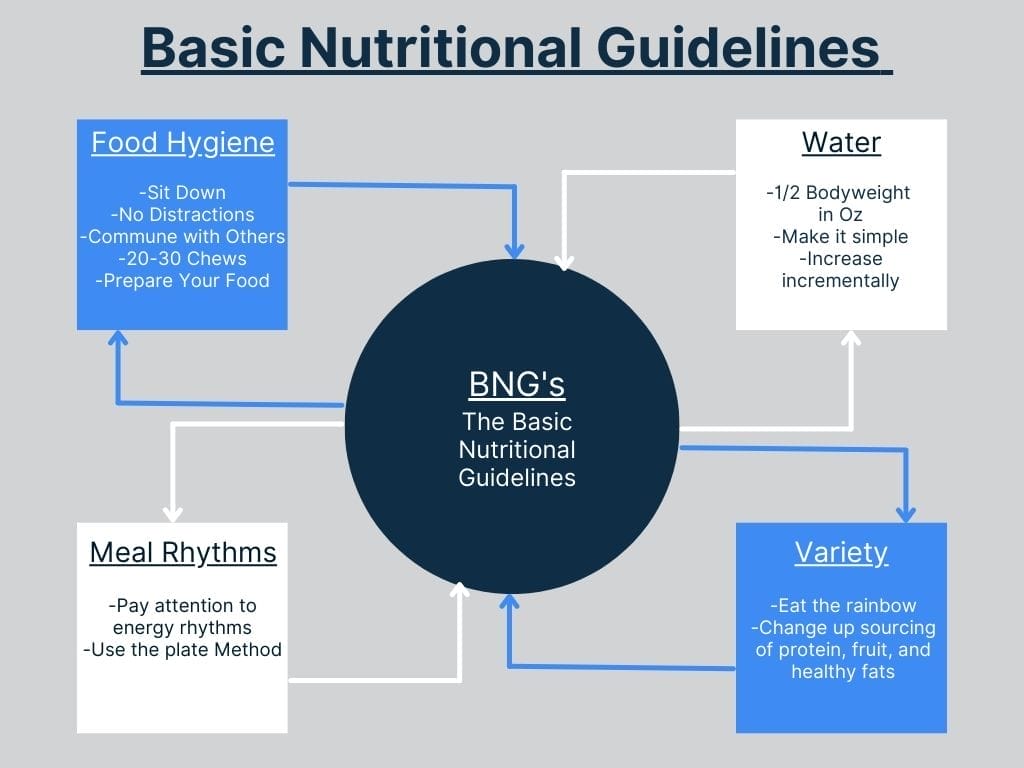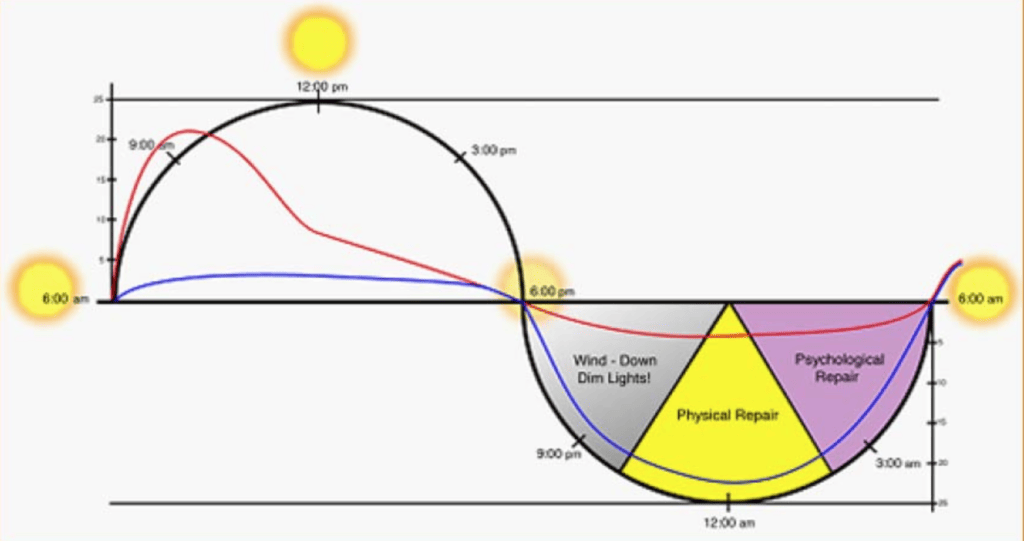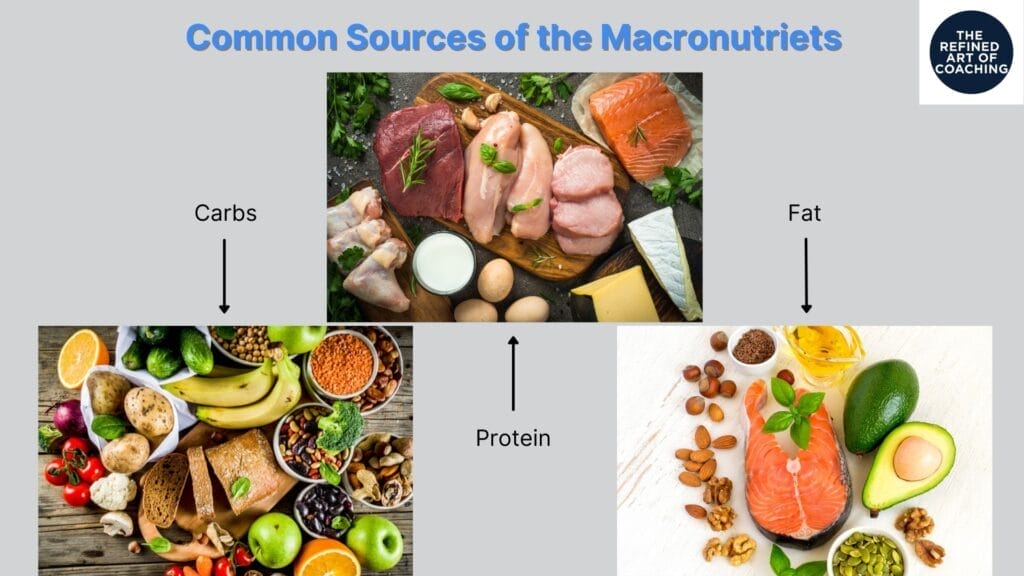In my last post, ‘About Those Calories,’ I teased something called The BNG’s – Basic Nutritional Guidelines. This is something that I created after more than twenty years of working with folks to have lasting success, not a quick or short-term fix. In a nutshell, it is a habits-based approach to coaching, built on a foundational layer of awareness. That last part is key because it brings *you* to the center of the process, thereby ensuring sustainability for the long run.
The BNG’s are a set of four simple areas that, if implemented, will lead you to nearly anything you want from a health improvement standpoint.
Said another way – any goal you have (body composition change, inflammation reduction, gut improvement, autoimmune condition, improved blood markers, reversing metabolic dysfunction, etc) is on the other side of mastering these areas.

Let’s break down each area:
First, there is Food Hygiene –
No, this isn’t about washing the dirt off your foods, HA! This area is all about maximizing digestion and nutrient absorption. The actions you take here are designed to activate your parasympathetic nervous system (PNS), which is responsible for helping you ‘rest and digest.’ Here are the some things to implement:
- Sit down to eat. This helps your heart rate come down and readies your body for meal time.
- Remove electronic distractions. No phone, no TV, no iPad. When your brain is continually bombarded by all the stimuli from a screen, it literally can’t devote the energy required to putting the PNS into drive.
- Enjoy your meal with others. Have conversation. Assuming the company is good, this will extend your time to finish a meal. This gives your food time to hit your stomach and activate the hormones that tell your brain that you are full.
- Be a part of the preparation of your food. Shop for it, chop it up, and cook it up before you eat it up. This all aids in the anticipatory process of digestion, activating the salivary glands that aid in, you guessed it, digestion.
- Chew each bite of food 20-30 times. This allows even more of the salivary juices to go to work in your mouth, where digestion actually begins. (Take note of how hard this is to do when you eat highly processed foods.)
- Reserve liquid consumption to before or after the meal. If you feel like you need water to moisten your palate, it’s because you haven’t done all of the above.
Second, there is Water –
You’ve probably heard that your body is made up of at least 60% of water. Along with macro- and micronutrients, it’s a major nutrient category that the body needs to survive. You can go weeks without food, but barely a couple days without water.
We didn’t even touch on all the good it does for digestion, supporting the area mentioned above.
And if you care about performance, consider this: degradation in power output begins with a 1% loss in hydration.
So how much should you drink? And when?
- Aim to drink half your bodyweight in ounces, per day. So a 160lb person would shoot for 80oz of water. Now, here’s the kicker -> if you barely drink any water at all, you shouldn’t jump right to half bodyweight. That’s a recipe for failure. Instead, make incremental adjustments. If you currently drink 10oz, try 12oz a day for the next 3 days. Then add another 3oz for 3 days. Then rinse and repeat until you hit your goal. While it might take a while, your body will adapt to it much better, making it far more sustainable in the long run.
- Set up your environment for success. Instead of running out to buy a new water bottle that you’ll leave places constantly or lose altogether, make this habit much simpler too. Put a glass of water right next to where you brush your teeth, so each morning when you get up that glass is right there waiting for you. Same thing for the coffee pot – leave a glass of water right next to that. And your workstation? Opt for a closed top bottle! I know it seems crazy – I’m asking you to leave glasses all over your house, but I promise this isn’t a long term thing. We just need to ingrain the water habit, and the best way to do it is by making it hard to not do it.
Next, we’ve got Meal Rhythms –
To be honest, this has got to be my favorite area within the BNG’s because I get the opportunity to talk about circadian rhythm, energy levels, and reverse engineering. The last piece of the rhythm puzzle is utilizing the plate method, which is a huge bonus tool!
Don’t run off just yet, I promise not to get deep into the woods with this stuff. To put it simply, circadian rhythm is just a way to assess how well we’re honoring our body’s natural sleep and wake cycle. And what is that natural cycle? You go to sleep when the moon comes up (and sun goes down) and you wake up when the sun rises. The kicker? When I say ‘natural’, I mean unaided by anything that helps put you to sleep (meds, alcohol, etc) or helps wake you up (alarm, caffeine, etc).
I’m very aware that putting out a beacon such as this can be overwhelming and discouraging, but it’s not intended to be. Just like a lighthouse in a dark storm on the ocean, it’s meant to be a guiding light, something to strive toward.
As for energy levels, you should be at your most alert 1-3 hours after waking, keeping this good mental acuity until you feel sleep slowly tugging at your eyelids in the early evening. You should not experience peaks and valleys of energy throughout the day.

This brings us to reverse engineering. What this boils down to is looking at the earlier mentioned sleep/wake cycle and energy rhythms of the day and figuring out why something is out of alignment with the ideal. It could be related to any number of things: your meal before bed, meal makeup (the foods themselves), shift work, kids, etc.
The first goal is just to become aware of the root of the problem. Solving comes later.
For instance, if you are having trouble waking up with energy in the morning, the solution is not more caffeeine or setting 39 alarms. The first step is looking back at the night/evening before and asking a few of the following questions:
- What did you eat for dinner?
- How much time elapsed between your last bite of food and when you went to bed?
- What is your sleep hygiene routine?
- Did you read a stressful work email before bed?
- Do your kids start back to school this week?
You see, all of these things can have an impact on your sleep, which will impact your body’s production of leption (the hormone that tells your body you are full) and ghrelin (the hormone that tells your body you are full).
As for the plate method, well that’s a simple tool for how to set up your plate at each meal. Half of your plate should be full of veggies, 1/4 should be protein, 1/8 should be healthy fats, and 1/8 should be a starchy carb.

Finally, we need Variety
This final area speaks to the importance of maximizing the nutrient density of the foods we eat – the macro- and micronutrients themselves.
This means that when it comes to fruits and vegetables, we should strive to “eat the rainbow.” Basically, don’t just eat red strawberries and green lettuce. Shoot for foods across all the colors in the rainbow.
As for the macros (protein, carb, and fat), you should get each of them from different sources as often as you can. Why? Because the nutrients you get from chicken are different than those in red meat…which are different than what you get from an egg, etc. Same goes for olive oil vs ghee vs raw dairy. All are great sources of fat, but have different nutrient profiles.

I hope that you’ve found value in this and will go out and start implementing some (shooting for all!) right away! Do it and I know you’re well on your way to achieving what you want most – sustained results.


